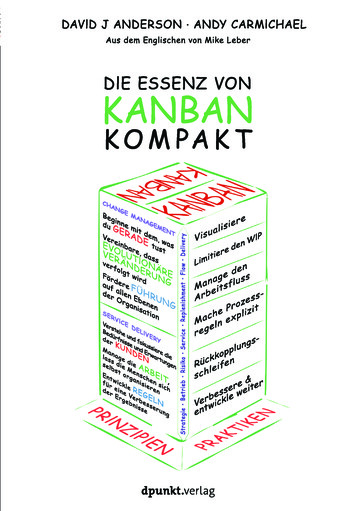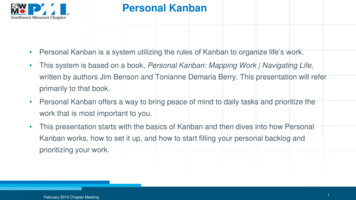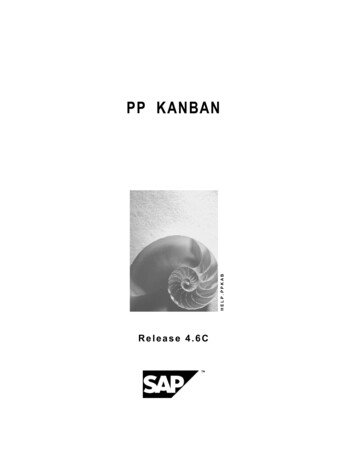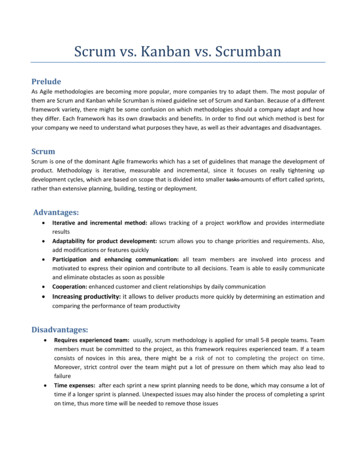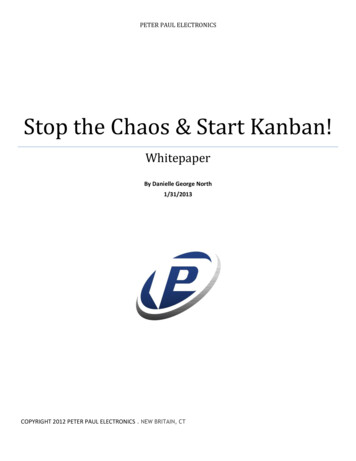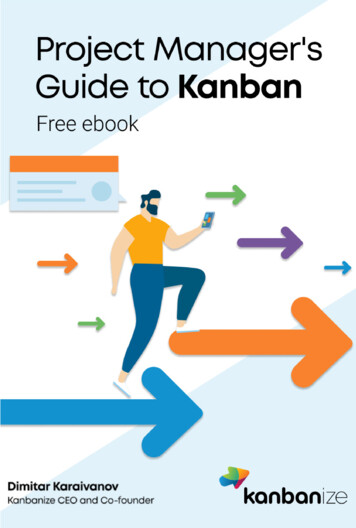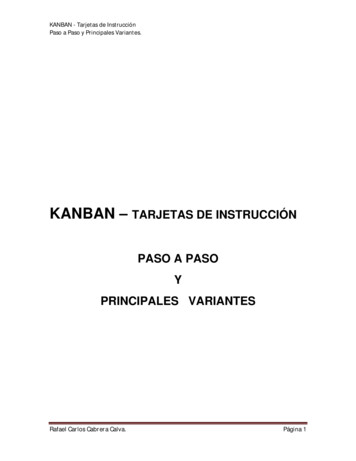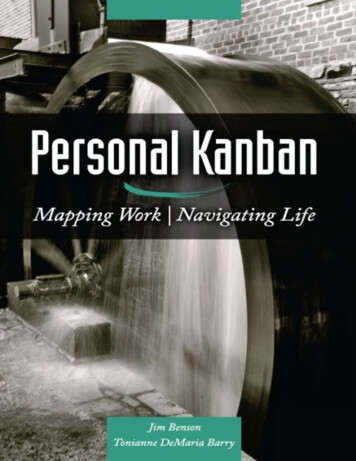
Transcription
ACCLAIM FOR PERSONAL KANBANWe’re all constrained to just 1,440 minutes a day, so balancing work, family, andsocial responsibilities can be a challenge. The simple innovation of visualizingyour work and limiting multitasking, explained in this engaging book, has meaddicted and is paying off big time. It just feels more natural than otherapproaches and gives me a tool that I can use to manage my work and calendarinstead of the other way around. Michael A. DaltonAuthor of Simplifying InnovationPersonal productivity systems usually fail in practice because of complexity—they don’t reflect the collaborative nature of real work. Personal Kanbanprovides the simplest structure that could possibly work and lets you achieve astate of flow. Ross MayfieldCEO of SocialTextAs an executive tasked with managing and creating innovation, my mind nevergets to stop work at 5pm. In my experience professionally and at home, themethods described in Personal Kanban have greatly increased my productivityand personal satisfaction. I’d highly recommend this book to anyone who feelsthe need to make their lives more manageable and their use of time moreeffective. Jabe BloomCTO of The Library CorporationPersonal Kanban shows you just how revolutionary the technique is. It’s a mustread for students to senior citizens who want to do fantastic work. PersonalKanban is simplistic and will become second nature; not only does it changewith you and your life, it will change your life. Patty BeidlemanEducator, Nonprofit Organizer, Caregiver, MomTrying to get more effective? Why use Rube Goldberg systems of tabulatednotebooks and special-purpose inserts? Instead, consider a system that flows likea stream and focuses your attention, both on the task at hand and on making your
process more effective. That’s what Personal Kanban is, and it may just fit yourthinking and doing style. Jerry Michalskiguide, Relationship Economy eXpeditionAn important new addition to the transliteracy toolbox. And I’m enjoying theiPhone app! Sue ThomasDirector of the Institute for Creative TechnologyDe Montfort University
PERSONAL KANBANMapping Work Navigating Lifeby Jim Benson and Tonianne DeMaria BarryFIRST MODUS COOPERANDI PRESS EDITION, JANUARY 2011 2011 Modus Cooperandi PressCover Photo: 2009 Tonianne DeMaria BarryTaken At: Aldie Mill, Aldie, VAE-book ISBN: 978-0-578-07985-1Cover Design: WayworksBack cover cartoon by Jim Benson using ToonDoo: http://toondoo.comImage on page 5, “Kanban Team at Work” used with permission by KenjiHiranabeBase image on page 49, “Trafficjam” used with permission by Lynac http://www.flickr.com/photos/lynac/321100379/
DEDICATIONLife is long. Life is short. We never do anything alone. Decades after they leftthis earth, the following people continue to inspire us. Their words and exampleat once fill our hearts and leave a void. It is to their memory we gratefully andlovingly dedicate this work.For Jim:Corey Sean Smith Who was the first person to truly help me realize my creativeside. Who taught me that creative, intellectual, and spiritual expression were oneand the same. Who was always more interested in doing than worrying. Who hasnever left my side.Nellie Gray Hill Benson Who was around very briefly in my life, but has alwaysbeen a model of what success really looks like. Driven, unassuming,uncompromising, flexible. You play the hand you are dealt.For Tonianne:Robert G. DeFelice Whose passion for the arts was rivaled only by his unbridledgenerosity and the enormity of his heart. My very own Uncle Drosselmeyer, heshowed me from an early age you are never too old for fairy tales, magic trulyexists, and angels most certainly walk among us.Anthony A. DeMaria Whose passing was an incomprehensible loss, but whosefaith in me is eternal. He was and remains my greatest teacher, and his wordscontinue to inspire me. His fierce loyalty, insatiable thirst for knowledge,distinctly Neapolitan sense of humor, and appreciation for la bella vita are but afraction of his bountiful legacy. It was a privilege to call him Daddy, and is aprofound honor to be his namesake.
TABLE OF CONTENTSTITLE PAGECOPYRIGHT PAGEFOREWORDThe Agony of Crisis ManagementINTRODUCTIONPersonal Kanban: 100% New Age FreeCHAPTER 1The Basics of Personal KanbanTowards a More Personal KanbanRules for a System That Abhors RulesWhy Visualize Your Work: Navigate SafelyWhy Limit Your WIPWhy Call it Personal KanbanHow to Use This BookPKFlow TipsCHAPTER 2Building Your First Personal KanbanStep One: Get Your Stuff ReadyStep Two: Establish Your Value StreamStep Three: Establish Your BacklogStep Four: Establish Your WIP LimitStep Five: Begin to PullStep Six: ReflectPersonal Kanban Power BoostersWhat it All Means
PKFlow TipsCHAPTER 3My Time Management is in League with the FreewayFlow Like TrafficSetting WIP LimitsLiving the Days of Our LivesClarity Calms CarlTo-do Lists: Spawns of the DevilPKFlow TipsCHAPTER 4Nature FlowsFlow: Work’s Natural MovementCadence: Work’s BeatSlack: Avoiding Too Many NotesPull, Flow, Cadence, and Slack in ActionBusboy Wisdom: The Nature of PullPKFlow TipsCHAPTER 5Components of a Quality LifeMetacognition: A Cure for the Common WisdomProductivity, Efficiency, and EffectivenessDefining a Good InvestmentReality CheckPKFlow TipsCHAPTER 6Finding Our PrioritiesStructure, Clarity, and Our Ability to PrioritizeSmaller, Faster, Better:Controlling Task Size and Limiting WIP
Prioritization in Theory and PracticeUrgency & ImportanceLive Your Own LifeExpert: Metrics in Personal KanbanPKFlow TipsCHAPTER 7Strive for ImprovementClarity Conquers AllCourse Corrections:The Reality of ReprioritizationThe Bedrock of IntrospectionRetrospectivesSolving Problems at Their SourcePKFlow TipsENDGAMEEndgameAPPENDIX APersonal Kanban Design PatternsJessica’s Story: Future in Progress andMultiple Value StreamsSequestering Approach:Dealing with Repetitive TasksEmergency Response Approach:Taming Unexpected WorkloadsTime Capsule ApproachBalanced Throughput ApproachAPPENDIX BPersonal Kanban and Social MediaFacebookTwitter
BloggingFOREWORDTHE AGONY OF CRISIS MANAGEMENTAs an avid reader of business literature and a recovering human capitalpractitioner, most recently as Deputy, Human Resources at the CentralIntelligence Agency, (retired), I’ve found Personal Kanban: Mapping Work Navigating Life both insightful and timely. As we all cope in our own way withmanaging our work schedules and balancing our personal lives, others’expectations of us and our expectations of ourselves, we all suffer from workand information overload. While attempting to keep pace with the myriadknowledge flows, three dimensional conversations and constantly changingpriorities among competing workflows, it is imperative that each of us formsnew ways with which to adjudicate work; interact with our professional andpersonal colleagues—and our calendars—with due consideration for balancingwhat I like to call our “crap to fun” ratio.Let’s face it: technology precedes anthropology. The knowledge explosion,advent of social tools, new enterprise architectures, and complicatedmultifaceted workflows coupled with the exponential expansion of availableknowledge and information is having a profound impact on how and when wedo our work. This new knowledge environment is also impacting how wefunction both physically and mentally. The seemingly constant pressure to makehundreds and even thousands of decisions per day, some large and some small,and then act on those decisions is innately stress-inducing. Some have postulatedthat even our physiological brain development is being altered by virtue of howmuch time and focus we expend online, via mobile devices and constant accessto information on demand.Amidst this chaos and increasing pressure to function at a high level in a digitalworld where every keystroke is persistent and every thought expressed digitallyimpacts both our productivity and our personal brands, we are all personally
challenged to keep our promises to others and ourselves, to balance work andfamily, the physical and the spiritual—while all around us our environments areevolving with increasing speed. Here, the gift to us all is resurrecting the triedand true concept of kanban, a “just in time” means of visualizing future, current,and past workflows that worked so well for the likes of Toyota (before theircurrent challenges) and others—and then applying this framework personally asPersonal Kanban.Years ago while serving in a particularly demanding overseas position, I cut outan ad for an old software product (I don’t even recall which one) that read:“Escape the agony of crisis management.” I posted this on the whiteboard in myoffice, which I used both to communicate with my staff and, unwittingly, tocategorize future work and work in progress against goals and objectives. In itsday, that whiteboard served as an analog social network—as various employeescame in to post updates and share information. It wasn’t until reading this bookthat I realized how much better my personal productivity and health could be if Iwere to use that same approach in my personal and professional life. This workmakes this methodology so clear and applicable to our personal lives, I now onceagain am using a whiteboard at my consulting practice using Personal Kanban asmy roadmap.The approach is both simple and elegant; clear and commonsensical. Withoutpretense or irrational demands, Personal Kanban offers several options forachieving better balance and peace of mind as we set about our daily tasks. Fromvisualizing your workflow, understanding that your capacity is not the same asyour throughput, to taking time to note your completed tasks (something atwhich I am very lacking, preferring instead to pummel myself immediately withthe next task), I have learned multiple lessons from this book. It belongs on thebookshelves, Kindles and iPads of every student of healthy personal andprofessional productivity. It is the kind of work that deserves to be bookmarked,highlighted and referred to often as we all tackle our dynamic workloads, whileconstantly prioritizing and reprioritizing the next steps in our shared but personaljourneys. Hopefully, you will find it equally useful, amidst all of today’sdistractions and high expectations, in escaping the agony of crisis managementand balancing your own crap to fun ratios.Tom McCluskeyDeputy, Human Resources (Retired)Central Intelligence Agency
November 2010INTRODUCTIONPERSONAL KANBAN: 100% NEW AGEFREE
I hesitated writing anything in this book that would smack of dimestore selfimprovement or seem unnecessarily huggy and harmonically convergent. Iwanted this to be a fun read—a practical one, to be sure—but certainly not onethat promises the holy grail of time management. You’ll find here nounwarranted claims of travel on the astral plane, or spiritual salvation throughtracking your work. I am no self-help sufi or productivity pontiff. I simply wantpeople to make conscious, informed decisions about the actions they take.Professional life. Personal life. Social life. They are often treated as separateentities, but our lives and insights cannot be segregated. Work / life balance is afalse dichotomy; compartmentalization is not sustainable. It forces life’sprofessional, personal, and social elements to vie for attention, bringing withthem seemingly competing expectations and goals. When we compartmentalizeour lives, these elements become pathological, pushing us from one task to thenext in an effort to satisfy their own jealous needs.A leisurely weekend spent with loved ones, a perfectly manicured lawn, awinning business plan, an impromptu night on the town. Family time, work time,what we create, what we enjoy—it’s all living. It’s what makes you who you are,me who I am. Ideally we would find a balance between our daily routine, theobligations we feel compelled to satisfy (but don’t excite us) and activities thatrejuvenate us and feed our souls. This can prove challenging, because money isboth a necessity and a major distraction.For most of us, at least half our waking hours are spent at our place ofemployment. We measure work by measuring time: billable hours, punches ofthe clock, overtime. We assess our time at work by its monetary value: thehourly rate, the project bid, time-and-a-half. We approach and validate our workwith an economic mindset: we work because we’re paid. When we lack the toolsto expand our relationship to work—our participation in it, our control of it—webecome careless about what it is that we actually do. An economic view of ourwork becomes our only view of our work. When time becomes a function ofincome rather than personal or professional value, we become psychologicallyand emotionally detached from our actions.If our goal is to live and work with meaning and purpose, this is not the
approach we want to take.As a supervisor and as an employee, I observed the impact of exchanging hoursfor dollars when time sheets were due. What the heck did I do on Wednesday?became a familiar lament. People were working so hard to complete work, theyforgot what they had actually accomplished. There was no time to revel inaccomplishments or even notice they had occurred.We’re all guilty of this, squandering our precious time merely trying to get by.We sequester joy for our evenings and weekends, scheduling time when weallow ourselves to live, rather than living all the time.Fulfillment should not be considered an indulgence.The following scenario is not uncommon: we go to work, we have little visibilityinto our co-workers’ actions while at the same time, we offer them littletransparency into our own. We are told to do work, but seldom understand why.We crave and deserve context. Without context, being told what to do is acommunication failure. We cannot make informed decisions or create a qualityproduct without first understanding why we are doing what we are doing. Lackof context creates waste, resulting in long work days, poor planning, and theinability to keep commitments outside the office.Hoping to avoid these common mistakes, I turned to the world of productivityand time management. I soon discovered that while the tools had usefulapplications, implementation was often cumbersome and convoluted; the toolsbecame chores. They took my time, energy, and focus. Some robbed me of myself-control. Even worse, most of these tools were solo flights, offering littleopportunity for collaboration. Those sorts of tools didn’t work for me. Toolsshould give you control and not take anything.I wanted to track and communicate my progress beyond the walls of my cubicle.I wanted to know where and when I could help my colleagues. I wantedcollaboration and effectiveness for me and my team. I wanted a map of my workdepicting not only the tasks at the office, but everything that mattered to me.Rather than being pushed by life, I wanted to pull life along with me.I wanted Personal Kanban.Personal Kanban is a simple, elegant mechanism that produces dramatic results.
It helps us manage ourselves, but also lets us share our work, our goals, and ourepiphanies with others. It’s a visual launchpad to personal effectiveness,spontaneous collaboration, and an integrated life. It’s low maintenance, but highyield. No crystals, no aromatherapy—just you, your work, and better planning.CHAPTER 1THE BASICS OF PERSONAL KANBANResident of the 21st Century, consider:Your boss wants you to finish that report.Your accountant wants you to file your taxes.Your friends want you to show up for tee time.Your garden wants you to prune the hydrangea.Your daughter wants you to attend her recital.Your father wants you to call your mother. It’s been two weeks, you know.Your bathroom wants you to re-caulk the tub.Your spouse wants you to just be present.Confronted with endless obligations, you are overwhelmed. Faced with anonslaught of demands, you can’t remember if you ate breakfast, much lessdeploy the mental reserves you need to survive the next two hours.Is this as good as it gets?Right now, all those things on your plate are just concepts. They are hard toprioritize, hard to analyze. You need a way to actually see the tasks you’reexpected to perform so you can do the right work at the right time, and bringsome clarity to the chaos. Personal Kanban is a visual representation of workthat makes the conceptual tangible. It shows what needs to be done, what iscomplete, what is being delayed, and what is going on at this precise moment.There’s a martial arts concept known as Shu Ha Ri, a cycle of learning wherefirst you learn the basics, then you question them, and finally you find your own
path. It’s not uncommon for someone coming to a book like this to want to betold what to do and how to do it, without ever understanding why. They wantquick steps to easy living. Life is not like that. It is variable. It changes whetherwe plan for it or not. Our systems need to be flexible to adapt to this variation.So, in this book we describe not only the mechanics of Personal Kanban, butalso the principles behind it. We want you to understand the why and not justhow to. Afterwards, you can discover how Personal Kanban practices fit intoyour life.TOWARDS A MORE PERSONAL KANBANIt’s been well over a decade since I first began exploring ways to visualizeworkload to better manage myself and my teams. From 2000 to 2008, I coowned a software development company called Gray Hill Solutions with mypartner William Rowden. Gray Hill created collaborative software forgovernment, usually in the area of Intelligent Transportation Systems. It wasthere that I first experimented with several visualization tools, including to-dolists, mind maps, and concept maps. To some extent, they all helped our teamssee their work, but they weren’t without their shortcomings. They would clutterquickly, fail to convey urgency, and become confusing when ad hoc teamscollaborated on a particular item.
Of all the tools we explored at Gray Hill, floor-to-ceiling whiteboards covered into-do lists proved to be the least effective. Rather than motivate us, we foundthem patronizing and demoralizing, revealing little more than the volume ofwork we faced. Thinking the medium might be at fault, we turned to databases,backlog management tools, even Microsoft Outlook to try to get lists to work forus, but the results were always the same: lists offered our work zero context,allowed for no reorganization or reprioritization, and obscured vital prioritiesbeneath piles of marginally useful work.What we needed was a system that was dynamic, one that would help usprioritize and show us what we were currently working on. We thenexperimented with managing several large, concurrent projects using a sharedmindmap. Using this visual control during our daily 15 minute stand-up, wewere able to manage a shared backlog, pull tasks from that backlog, and limitour work-in-progress.1The mind map made Gray Hill staff positively giddy. It was the first time ourgeographically dispersed group had a constant and fairly comprehensive idea ofwhat was going on. But while the mind map was a significant improvement overthe to-do list, it was still lacking. It didn’t help us complete tasks or distinguishbetween work shared by multiple people. Its greatest limitation was that theinformation conveyed was not obvious. Text-based and small, with 8 point type
on tiny branches, it offered us little ability to get a status-at-a-glance. As aproject management tool it was useful, but it wasn’t the information radiator wewere seeking.Fast forward to 2008. Corey Ladas, David Anderson, and I started ModusCooperandi—a company built around collaborative management. At this pointwe’d all been using kanban-based management systems for softwaredevelopment: David and Corey at both Microsoft and Corbis, I at Gray Hill.2With kanban, we visualized the current work of our development crew on stickynotes as they traveled through a value stream—a graphic depiction of the stepsin the software development process. The system was both simple and effective.Kanban for software development worked great for managing software creation,better than anything we’d used before. Its focus on team work increasedproductivity and effectiveness brilliantly. But we were overlooking a vitalelement—the individual team member. We still needed to understand howprocesses impacted our personal work.It was at Modus that Corey and I put our heads together and created a personalkanban to visualize and manage our team’s personal work. Our board wasspecifically designed to be an information radiator: we wanted it to show theflow of our work (even from a distance), limit our work-in-progress, and captureall tasks, not just those directly related to software production.
We paid close attention to the board’s nuances. During our weekly retrospectiveswe discussed what was working, and what wasn’t going as expected. Weexperimented with various formats, exploring ways in which this new toolworked best for the individual, and where it performed best for the team.One thing was certain: in front of our board, we experienced our most intensefocus, enthusiasm, and camaraderie. For the first time we could visualize ourwork—we could see its relationships and contexts—and we could interact withit. Beyond simply validating our productivity, our board fostered discussions thatwere expansive, enthusiastic, and revelatory. It stretched us far beyond our dailygoals, taking us into exciting new realms of possibility.We were operating under some basic assumptions taken from Leanmanufacturing models.3 We were visualizing work, limiting our work-inprogress, pushing decisionmaking to the last responsible moment, andcontinuously striving to improve. We learned that understanding our work is thekey to controlling it.In a manufacturing setting, organizational kanban visualizes how value iscreated, usually in the service of reducing waste and creating standard work.Adhering to this rule proved difficult in an office dominated by knowledge work.Knowledge work fights vigorously against standardization.4It would take one more transition and several epiphanies to get beyond theseissues.
In the middle of 2009, Corey went on a year-long sabbatical. Around the sametime, I was offered a long-term opportunity in Washington D.C. Since David hadleft Modus to start his own company in late 2008, it made sense to close theoffice that after ten years and two businesses was packed with files, furniture,and work products.Suddenly I was forced to deal with land management and insurance companies,telephone and internet service, selling office furniture, and finding temporaryhousing in D.C. The window to deal with these logistics was just a few shortweeks and there were still client demands to be met. My personal life didn’t takea break, either. I was moving across the country, and still had responsibilities tothe two properties I owned in Washington State.Even with the help of some very good friends, I found myself with morecommitments than I could handle. The demands of multiple companies, clients,projects, and homes threatened to destroy my sanity. The overlapping nature ofmy work life, home life, and social life became clear. My need to quicklycomplete a disparate, overwhelming backlog produced a series of epiphanies:Personal projects materialize out of nowhere.Personal projects are often short-lived.Personal projects can have their own unique visualizations.Personal work is often unpredictable.Personal work is difficult to manage.The only way out is “through.” Often, you can’t delegate, procrastinate, orignore personal work.Context dictates the way we prioritize our personal work.Prioritization for personal work happens at the moment of doing.Other people’s expectations of you do not disappear simply because youare overworked.Personal and professional life are not distinct and should not be artificiallyseparated.Risk for individuals is inherently different from risk for a company.
I came to the realization that—like this photo—personal work is messy.“Organizational” kanban is used to seek predictability in work throughvisualization and refinement. While personal work can be calmed and tamed, itresists standardization. Therefore, “Personal” Kanban needed to be flexibleenough to relate to an extremely variable or even chaotic workload.I needed insight into how my work was being carried out, and how best to calmthe stress. So I built that kanban—affectionately known as “Crapban.” It wasdesigned to deal with my laundry list of epiphanies, most important of whichwas that it needed to elegantly manage a highly variable workload and react to adynamic work-in-process limit.And it worked!In a short span of time I burned through a substantial amount of work. When Iwas done, I knew exactly what I had accomplished, how long it took, whatobstacles held me up and why. I was elated. My Personal Kanban showed meexactly what I’d done—quite the opposite of not knowing what to put on yourtimesheet!Note: If you look closely at the left side of the Crapban grid, you’ll notice I gaveall those tasks initial prioritizations. Looking at what was accomplished, you cansee that my initial prioritizations were quickly overcome by events. Premature
prioritization was ultimately a waste of my time. Prioritization for personal workis highly contextual. Case in point, “Cancel L&I” was initially scheduled as task#14, but L&I called unexpectedly one morning and most of what I needed toaccomplish with them was easily handled during that call. The context changedand so the priority changed.Soon after I arrived in D.C., Tonianne DeMaria Barry and I continued to use,test, and blog about Personal Kanban. The approaches we wrote about werevariations we used to get beyond my frenetic office closing and cross-countrymove, and begin doing business with our new clients.It wasn’t long before we began hearing from people around the globe who readthe blog and tried Personal Kanban. Some were using it to organize theirhouseholds, some to track student progress in their classrooms, some to managea family member’s treatment for a life-threatening illness.Opportunities to use Personal Kanban professionally soon followed. Ourengagement with the World Bank reinforced the flexibility of the PersonalKanban model. Planning to use it with a global team of scientists andresearchers, we quickly discovered the Personal Kanban featured in most of ourblog posts didn’t fit with their unique needs. They needed to track more thansimply work. Their context demanded that they track real-time issues, individualprogress, and team progress every 20 minutes. We immediately created a newPersonal Kanban visualization to display these elements and manage theirparticular workflow.
Personal Kanban has to be endlessly flexible. It needs to be a system that abhorsrules. It’s an enigma. A process that hates process.How is this even possible?RULES FOR A SYSTEM THAT ABHORS RULESAll too often companies respond to business needs by shopping for “proven”solutions, repeatable processes to achieve a desired outcome. They call these“best practices,” which for many translates into Don’t tell me why somethingworked, tell me how they did it. Rote, universal solutions exhibit little respect forthe individuality of a problem, and epitomize lazy management. Their adoptionoften spawns professional organizations which certify legions of consultantsselling one-size-fits-all processes. The end result is that good initial ideasbecome codified and ineffective industry dogma.Imagine if I told you I had a simple, ten-minute technique—or worse yet, atwelve month program—guaranteed to fix any broken marriage simply becauseit was built on marital best practices. How skeptical would you be? My guess(and my hope) is that your response would range between highly skeptical todownright disgusted. Instinctively, we understand that every relationship has its
hardships and its happiness. On a personal level, we intuitively recognize thatlife is fraught with variation.We appreciate and accept this variation when it comes to interpersonalrelationships. So why not accept it in all aspects of life, including business?Our lives are not static, and neither is our work. Personal Kanban evolves as ourcontext changes, encouraging us to innovate and invent in response to thevariation we encounter daily.Our goal with Personal Kanban is to say No to those who presume to have ourwork all figured out. To say No to imposed processes that limit our ability tocreate false hopes of enforcing predictability.The Two Rules of Personal KanbanRule 1: Visualize Your Work.It is challenging to understand what we can’t see. We tend to focus on theobvious elements of our work (deadlines, individuals involved, the amount ofeffort needed) when the real context includes larger, unexpected, and morenebulous elements (passage of time, changes in the market, political impacts).Visualizing work gives us power over it. When we see work in its variouscontexts, real tradeoffs become explicit. We now have a physical record of allthose demands on our time. This larger view of our work and our context allowsus to make better decisions. We can heartily embrace one task, while politelydeclining another.
Rule 2: Limit Your Work-in-Progress (WIP).We cannot do more than we are capable of doing. This should seem obvious, butit’s not. Our capacity for work is limited by a host of factors including theamount of time we have, the predictability of the task at hand, our level ofexperience with the task type, our energy level, and the amount of work wecurrently have in progress. Limiting WIP allows us the time to focus, workquickly, react calmly to change, and do a thoughtful job.With Personal Kanban, principles take precedence over process. Process shouldchange with context. Whether you choose to use a wh
ACCLAIM FOR PERSONAL KANBAN We're all constrained to just 1,440 minutes a day, so balancing work, family, and social responsibilities can be a challenge. The simple innovation of visualizing your work and limiting multitasking, explained in this engaging book, has me addicted and is paying off big time. It just feels more natural than other
